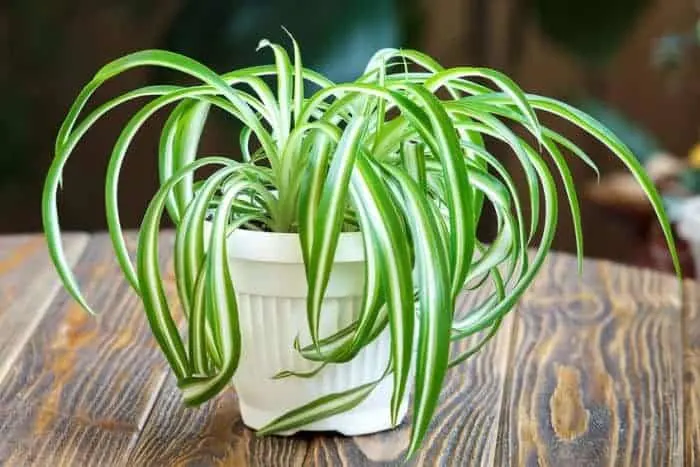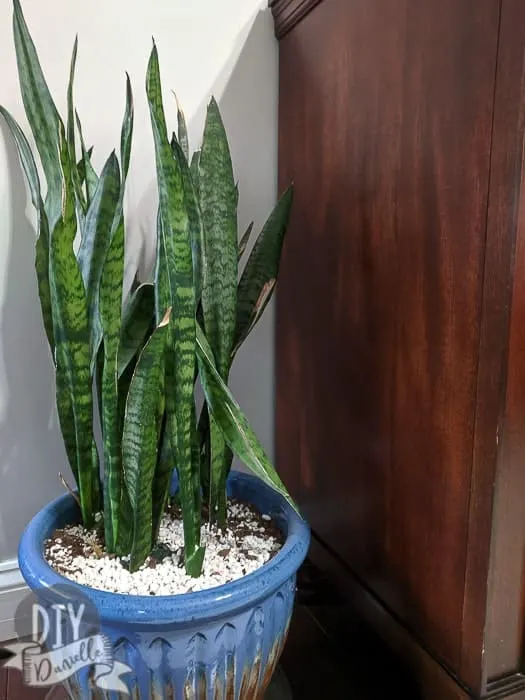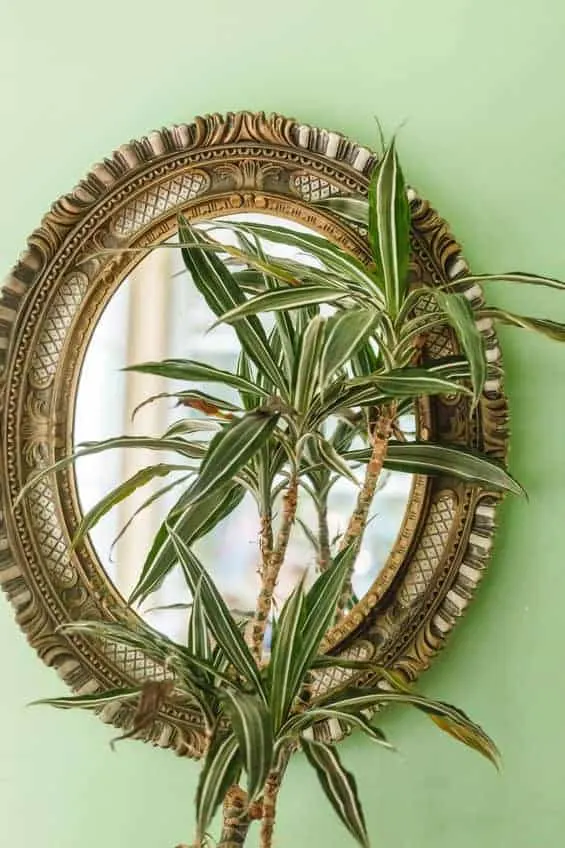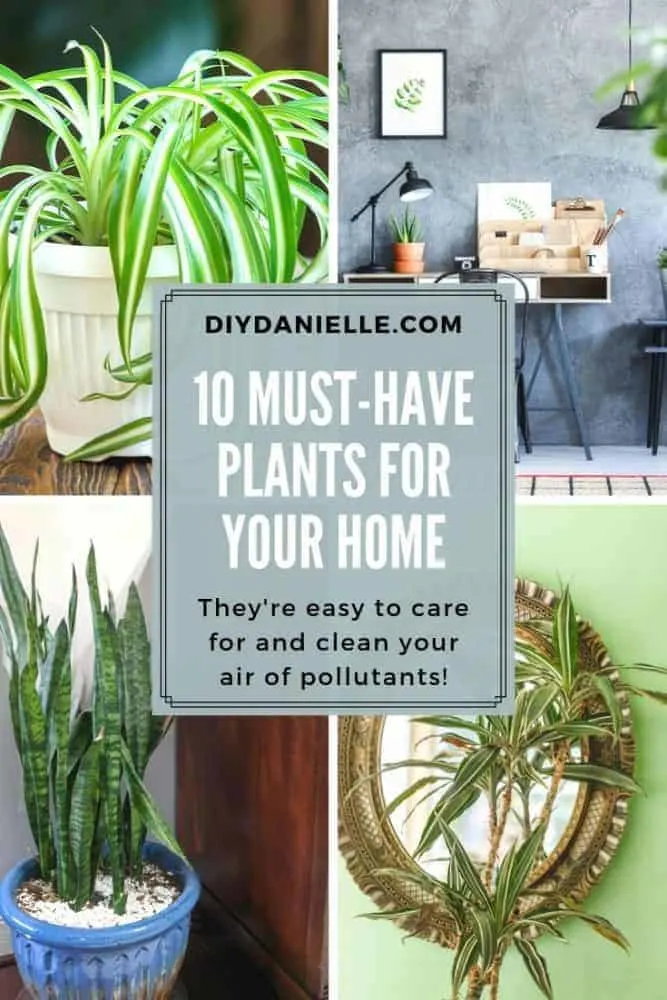
Do you worry about your home’s air quality? Here are 10 plants you can grow inside your home to clean the air and how many plants you need to do the job!
This post may contain affiliate links which may earn me commissions should you click through them and take certain actions. As an affiliate for Amazon, Cricut, xTool, Home Depot, and other sites, I earn from qualifying purchases. Please DIY carefully. View my full legal disclosures here.
Please read the whole post so you don’t miss any important information!
Hi everyone! Indoor plants are one of my favorite things to add to a home. Even without the science behind it, healthy and happy indoor plants make a home FEEL cleaner and healthier. I breathe easier with live plants in my space. Today’s guest post is written by Katie Matthews of GreenActiveFamily.com. Make sure to check out her blog for ideas on raising green, active kids! Enjoy! -Danielle
How to Reduce Indoor Air Pollution Using Easy-to-Care for Clean Air Plants
Since the late 1980s, we’ve known that indoor houseplants are pretty much superheroes when it comes to indoor air pollution.
That’s when NASA (yes, NASA) released a study showing that special clean air plants can purify indoor air, sucking out carbon dioxide and volatile organic compounds (VOCs) like benzene, trichloroethylene, and formaldehyde.
Research conducted since has more or less backed up NASA’s findings. It’s provided us with even more information about how certain plants can make our indoor air much healthier by removing toxic chemicals and carbon dioxide from our homes, while also increasing fresh oxygen.
While some research suggests all plants help clean our air somewhat, there are a handful of clean air houseplants that really excel at it.
Happily enough, many of them are easy-to-care-for plants that will tolerate low light, drought, and general neglect from novice gardeners (and those of us who are just really busy).
Which Chemicals Can Clean Air Plants Remove?
Clean air plants are particularly good at removing volatile organic compounds (VOCs) from the air in our homes.
VOCs are carbon-containing chemicals that tend to exist as gases at room temperature.
They get into our home through our everyday activities and the products we use. VOC chemicals are found in products such as foam furniture, furniture varnish, vinyl building products, and cosmetics – but they’re often not chemically bound to those products. When they get into our home, they can “escape” or off-gas from the products, polluting our indoor air.
New car smell is caused by off-gassing VOCs, as is the stink many customers find comes with memory foam mattresses.
Some of the VOCs plants can remove include formaldehyde, benzene, trichloroethylene, toluene, and xylene.
The International Agency for Research on Cancer (IARC) classifies formaldehyde, benzene, and trichloroethylene as Class 1 carcinogens (carcinogenic to humans). They classify xylene and toluene as Group 3 carcinogens, which means they’re unclassifiable based on the evidence currently available.
Despite research demonstrating many of these chemicals are toxic, they’re all around us.
According to the World Health Organization (2010), adults in the United States are estimated to inhale between 180 and 1300 μg per day of benzene.
Formaldehyde concentrations in indoor air vary, but studies conducted in North American, Europen and Australian homes have found them to vary between 8.1 μg/m3 and 133.7 μg/m3.
In the United States, the US EPA has found the average concentration for trichloroethylene in indoor air is 7.36 µg/m3. Trichloroethylene concentrations in indoor air are generally higher than outdoors.
The bottom line? It’s worth learning how to remove these chemicals from one of the places you spend the most time: your home.
Choose These 10 Air Cleaning Plants for Your Home
Spider Plants
According to the NASA Clean Air Study and studies since, Spider Plants (Chlorophytum comosum) are effective at removing formaldehyde, xylene, benzene, trichloroethylene, carbon monoxide and nitrogen dioxide from the air.
In equally good news, they’re also super easy to grow and care for. Spider Plants are tough, making them a perfect choice for anyone who wants to clean their indoor air, but lacks a green thumb.

Boston Fern (also known as Sword Fern)
Researchers have found ferns are one of the best indoor house plants for anyone wanting to remove formaldehyde from the air.
The NASA Clean Air Study found the Boston Fern (Nephrolepis exaltata), in particular, to be the most effective formaldehyde remover in the study, removing significantly more per hour than the rest of plants examined. This has been backed up by research since.
Boston Ferns do double duty, as they also clean the soil, eliminating heavy metals like mercury and arsenic.
Boston Ferns are pretty easy to care for, but they need plenty of bright light and water. They’re a good choice for areas of your home with lots of natural light.
Snake Plant / Mother-in-Law’s Tongue
Researchers have found Snake Plants (Sansevieria trifasciata, also known as Mother-in-Law’s Tongue) are one of the most effective plants to remove toluene from your air. This popular houseplant also removes formaldehyde, benzene, trichloroethylene, and xylene.

Snake Plants are one of the easiest houseplants to grow. They don’t require much light or water, you can leave them for weeks at a time, and they’re not plagued by insects or pests.
Dracenas (Janet Craig, Red-Edged, Cornstalk, and Warnecki)
Studies have found several dracenas are effective as clean air plants.
The NASA study (and studies since) have found the Red-Edged Dracaena (Dracaena marginata) to be effective at removing benzene, formaldehyde, trichloroethylene, toluene and xylene from the air.

The Janet Craig (Dracaena Deremensis), Cornstalk (Dracaena fragrans), and Warnecki (Dracaena deremensis) are effective at removing benzene, formaldehyde, and trichloroethylene.
Researchers studying Janet Craig dracaenas found a 50% reduction in total VOC concentrations in offices with three or six of these plants, as compared to offices without plants.
If you’re considering adding dracena plants to your home, they don’t need a lot of light, humidity, care, or water. In fact, you can keep them on the dry side.
Chinese Evergreen
According to the NASA Study, Chinese Evergreens (Aglaonema) are good at removing benzene and formaldehyde from the air.
Although it’s not as efficient as some of the other plants on this list, Chinese Evergreens are so easy to care for, they’re a no brainer addition to your home.
According to Gardening Knowhow, Chinese Evergreens are “one of the most durable houseplants you can grow, tolerating poor light, dry air and drought.”
Philodendrons (Heartleaf and Selloum)
Several philodendron types have been studied as clean air plants, including the heartleaf (Philodendron cordatum) and Elephant Ear / Split-Leaf Elephant Ear (Philodendron selloum). These plants remove formaldehyde while also adding oxygen to your home.
More easy-to-care-for indoor houseplants, philodendrons need bright, indirect sunlight and some occasionally fertilizer. When it comes to water, they need moist but not soggy soil conditions.
How to Use Plants to Clean Your Air
While adding a few of these plants to your home certainly won’t hurt your indoor air quality, you should also consider how many plants you need to clean your air.
Bill Wolverton is the former NASA scientist who conducted the Clean Air Study. According to him, two or more “good sized” plants for every 100 square foot of space is a good start. He also recommends a starter plant we haven’t covered in this article – the golden pothos.
“I usually recommend the golden pothos as my first choice, since it is a popular plant and easy to grow.”
That said, you should adjust how many plants you use based on your unique situation:
- Urban homes tend to have higher concentrations of many chemicals than rural homes. You may want to use more plants if you live in a busy city, or near congested roads.
- Homes that have been recently renovated (within the last year) or have new products, such as laminate furniture or flooring (added within the last year), tend to have higher concentrations of some chemicals. Again, consider adding more clean air plants to your home in this situation.
Author Bio, Katie Matthews
Founder and Editor of GreenActiveFamily.com, Katie was born and raised on Canada’s west coast. She became acutely aware of the toxins and chemicals allowed in baby products when she was pregnant with her daughter. Long an enthusiastic researcher and writer, she realized she could help other families make more informed, non-toxic purchases for their own families by sharing what she found.
Prior to starting GreenActiveFamily, Katie spent close to a decade as a travel blogger, and has written for National Geographic. Katie, her lifestyle, and her products have been featured in the Washington Post, Business Insider, The New York Times, and more.
Please share and pin this post! If you make this project, share it in our Stuff Mama Makes Facebook Group. We have regular giveaways for gift cards to craft stores. You can also tag me on Instagram @doityourselfdanielle; I love seeing everything you make!

Interested in gardening? Here are some other posts about gardening that I’ve written and you might enjoy: DIY Concrete Planters | Privacy Planters | How to Use Pine Straw as Mulch | 13 Stunning & Easy Garden Trellis Ideas | How to Setup a Pond and Patio | Gifts to Make from the Garden | Everything You Need to Know about Grow Lights
